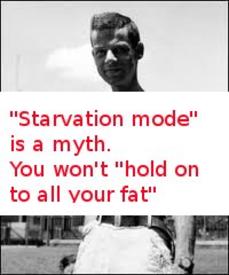To those of you who REALLY understand TDEE vs NEAT
Options
Replies
-
We store glycogen and fat after eating a surplus amount of calories, but a 10 hour overnight fast sees off any post meal digestion doesn't it ? Hence all the fasted blood tests, RMR etc done in the morning after overnight fast.It also ignores the fact that caloric intake has differing digestion, absorption and utilization rates. What you eat one evening can easily be available as an energy source the following day. By far the most important aspect is to time the calories in a way to maximize training, so you may well end up eating more on lift days - but if you lift in the morning, you may well want to eat more the evening before.0 -
bump0
-
So... I've been doing this for the last few days, and so far I like it. But I realized something last night...
My original proposal was to set your daily calorie goal EQUAL to your BMR + TEF + NEAT (or, if you prefer, TDEE - exercise) and not log/eat back exercise. As you log food, you get closer and closer to you daily calorie goal and MFP's calories remaining number gets closer and closer to 0.
Pretty basic stuff right there.
One of the potential issues with this approach is very large deficits due to big cardio workouts.
But...
If you were to log exercise, then that calories remaining number would be your current deficit at any given time. As you log foods eaten, the calories remaining number decreases and your deficit gets smaller. As you log exercise it goes up and your deficit increases.
This makes it incredibly easy to manage your deficit. Most days you'll still be eating that same base number of cals (TDEE - exercise), do it's still a fixed intake approach. But it's very easy to see if your deficit is getting too high on any given day, at which point you could simply eat a bit more to make for a more reasonable deficit.
Yes, it means logging exercise, which I was hoping to get away from, but in some cases it might be worth the extra logging.0 -
OP - thanks for the recommendation to visit. Very informative stuff here! All the best!0
-
I know and understand my BMR and TDEE. How / where to you calculate NEAT. I workout every day and recently started wearing a pedometer to ensure my NEAT is good...just don't know what NEAT numbers are.0
-
So... I've been doing this for the last few days, and so far I like it. But I realized something last night...
My original proposal was to set your daily calorie goal EQUAL to your BMR + TEF + NEAT (or, if you prefer, TDEE - exercise) and not log/eat back exercise. As you log food, you get closer and closer to you daily calorie goal and MFP's calories remaining number gets closer and closer to 0.
Pretty basic stuff right there.
One of the potential issues with this approach is very large deficits due to big cardio workouts.
But...
If you were to log exercise, then that calories remaining number would be your current deficit at any given time. As you log foods eaten, the calories remaining number decreases and your deficit gets smaller. As you log exercise it goes up and your deficit increases.
This makes it incredibly easy to manage your deficit. Most days you'll still be eating that same base number of cals (TDEE - exercise), do it's still a fixed intake approach. But it's very easy to see if your deficit is getting too high on any given day, at which point you could simply eat a bit more to make for a more reasonable deficit.
Yes, it means logging exercise, which I was hoping to get away from, but in some cases it might be worth the extra logging.
Okay you have a math / statistics background!!! Please run my numbers and I will be forever indebted. 0
Please run my numbers and I will be forever indebted. 0 -
I know and understand my BMR and TDEE. How / where to you calculate NEAT. I workout every day and recently started wearing a pedometer to ensure my NEAT is good...just don't know what NEAT numbers are.
NEAT is basically what MFP estimates.
I know mine because I've been doing this long enough, with enough attention to detail and consistency, to know how many calories I need to maintain.0
Categories
- All Categories
- 1.4M Health, Wellness and Goals
- 391.7K Introduce Yourself
- 43.5K Getting Started
- 259.8K Health and Weight Loss
- 175.6K Food and Nutrition
- 47.3K Recipes
- 232.3K Fitness and Exercise
- 395 Sleep, Mindfulness and Overall Wellness
- 6.4K Goal: Maintaining Weight
- 8.5K Goal: Gaining Weight and Body Building
- 152.7K Motivation and Support
- 7.8K Challenges
- 1.3K Debate Club
- 96.3K Chit-Chat
- 2.5K Fun and Games
- 3.3K MyFitnessPal Information
- 23 News and Announcements
- 960 Feature Suggestions and Ideas
- 2.3K MyFitnessPal Tech Support Questions




